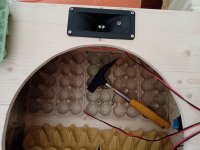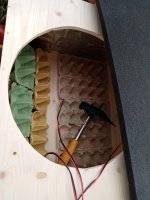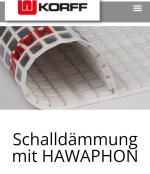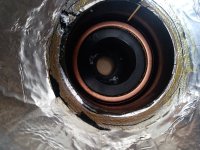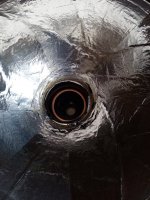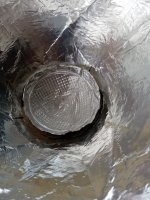A thread on this topic could be an inspiration for newbees & interested folks
Here some ideas I realized:
glued in egg crates (the real ones) and using a thin sheet of damping. Thats for being localized more in the middle of the box where it is damping lower frequencies than only being positioned on the walls
reflex port in the corner of one wall as a cutout and port made of cardboard sheets glued in. Easy to realize bigger port diameters like this.
piezo tweeter on the side for indirect high frequency dispersion but it can be put on and off to taste
Here some ideas I realized:
glued in egg crates (the real ones) and using a thin sheet of damping. Thats for being localized more in the middle of the box where it is damping lower frequencies than only being positioned on the walls
reflex port in the corner of one wall as a cutout and port made of cardboard sheets glued in. Easy to realize bigger port diameters like this.
piezo tweeter on the side for indirect high frequency dispersion but it can be put on and off to taste
Attachments
@picowallspeaker
correct. lead is very good for damping resonant walls.
In germany its not allowed in commercially available loudspeakers.
Lambs wool I still have half a ton of it from isolating my house.
But would not use it for reflex boxes.
correct. lead is very good for damping resonant walls.
In germany its not allowed in commercially available loudspeakers.
Lambs wool I still have half a ton of it from isolating my house.
But would not use it for reflex boxes.
once I saw in the 90ies a french hifi shop owner using lead.
He made a mass loaded construction of a loudspeaker enclosure:
38 mm particle board and four layers of lead sheets glued with ceramic glue which got hard after finishing binding process.
He made a mass loaded construction of a loudspeaker enclosure:
38 mm particle board and four layers of lead sheets glued with ceramic glue which got hard after finishing binding process.
Zinc is a possible substitute for lead sheet, but although its soft its not as soft as lead. Tin would be a great substitute but its a lot more expensive. Cutting mats are quite flexible and heavy, possible alternate material too?
@Mark Tillotson
a good choice would be Hawaphon from Korff, germany.
https://www.korff.ch/produkte/hawaphon/
a good choice would be Hawaphon from Korff, germany.
https://www.korff.ch/produkte/hawaphon/
Attachments
A tweak for fullrange drivers is putting away the dustcap.
Its probable to get more highs like this.
This is due to a lot of added emanating surface which is enclosed by a dustcap.
So if dust is not a problem.
See "how to make a whizzer cone" for diy adding of dustcap / whizzer directly to a voice coil.
This 38cm loudspeaker is prepared for a marriage with a piezo tweeter at 4khz.
Also added diy a copper ring on the pole piece. See extra thread on this "how to faraday".
Measurement on axis near field 15cm. Above 3khz more radiation without dustcap.


Its probable to get more highs like this.
This is due to a lot of added emanating surface which is enclosed by a dustcap.
So if dust is not a problem.
See "how to make a whizzer cone" for diy adding of dustcap / whizzer directly to a voice coil.
This 38cm loudspeaker is prepared for a marriage with a piezo tweeter at 4khz.
Also added diy a copper ring on the pole piece. See extra thread on this "how to faraday".
Measurement on axis near field 15cm. Above 3khz more radiation without dustcap.
Attachments
you can adjust the amount of optimal resistance to your speaker by grouping single litz wires together until the sound gets right.
here I used three single litz wires until it was perfect.
This is for home hifi only! Not PA use!

here I used three single litz wires until it was perfect.
This is for home hifi only! Not PA use!
- Home
- Design & Build
- Construction Tips
- Tips & Tricks loudspeaker building How to
